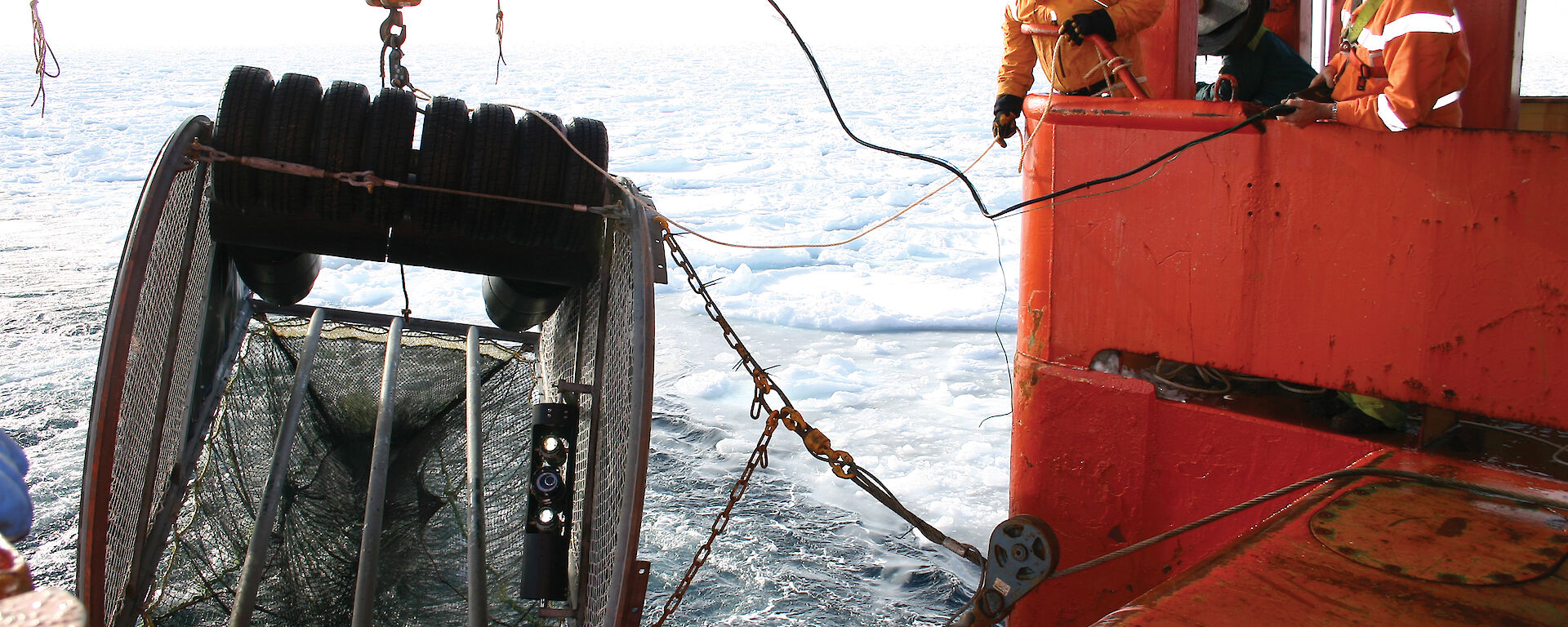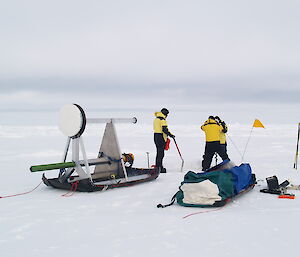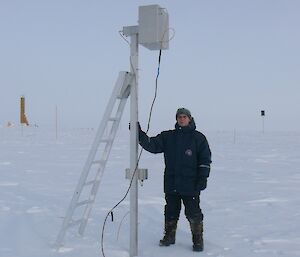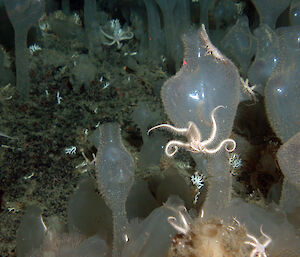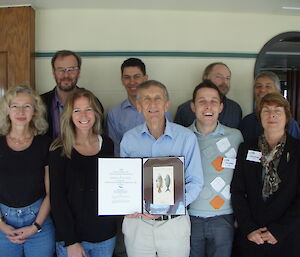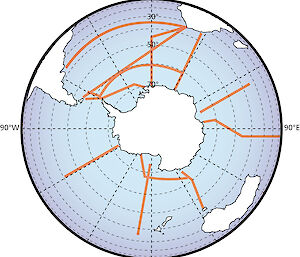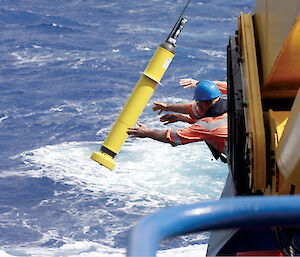During the IPY, five Australian-led research projects made significant advances in scientific understanding in Antarctica and the Southern Ocean (see below for details). Australia also contributed to many other international projects. For all projects, the IPY provided an opportunity to collaborate with scientists from different nations and different scientific disciplines, enabling research on a larger and more comprehensive scale than ever before.
Many of the projects gathered information which has been, or aims to be, stored in broadly accessible databases. These data are a key IPY legacy and will be invaluable for future research and, in some cases, will provide benchmark information against which environmental change can be observed. A number of observational systems and associated infrastructure were also established, and equipment installed, which will enable continued and long-term research. Some research has already instigated practical changes that will assist future conservation of the Antarctic environment.
As well as building relationships with new and existing scientists, science students and research institutions, Australian IPY scientists also engaged with the general public. A range of public outreach and education activities were conducted, including IPY days, school visits, and the creation of web blogs and educational and scientific websites.
Altogether, the success of the Australian projects in delivering on the four major goals of the IPY – advances in polar knowledge, a legacy of infrastructure and observational systems, inspiring a new generation of scientists, and public outreach – will ensure the scale, success and broad understanding of Antarctic research, made possibly by the IPY, will continue.
Aliens in Antarctica
Aliens in Antarctica is the first major investigation into the effect of human activities in Antarctica on the invasion potential of alien (non-native) species. Over the 2007–08 summer an international team of scientists from nine nations, coordinated by the Australian Antarctic Division, investigated the likelihood of the introduction of non-native species across a wide range of national Antarctic programs and tourist operators.
Teams examined the type and number of ‘propagules’ (seeds, spores and eggs) that could be unintentionally imported into Antarctica on personal clothing and equipment, fresh food, cargo, and more than 40 ships and aircraft. Crews and passengers were also surveyed to ascertain the extent of travel that people had done before heading south, to identify the geographic range from which invasive species could be drawn.
The Australian team examined over 2000 items of fresh fruit and vegetables destined for Australian Antarctic stations and conducted laboratory-based simulations to look at seed dispersal and germination. Details of this work are described in Australian Antarctic Magazine 14: 28, 2008. As a result of this research the scientists recommended that certain produce should not be accepted within the Australian Antarctic program in future.
Data and information gathered during the project are now being analysed and will be reported at Antarctic Treaty meetings; at the Scientific Committee on Antarctic Research Biology symposium; and through the scientific literature. Ultimately, the information will be used to improve conservation and protection practices in the Antarctic region and other sensitive areas around the world.
Sea Ice Physics and Ecosystem Experiment
The Sea Ice Physics and Ecosystem eXperiment (SIPEX), involving 45 scientists from 12 countries, has improved scientists’ understanding of the relationship between sea ice physical processes and the biological environment within and under the ice. The program, led by the Australian Antarctic Division and the Antarctic Climate and Ecosystems Cooperative Research Centre, was conducted on a 55-day multi-disciplinary sea ice voyage, at a time of maximum sea ice extent in East Antarctica. During this time scientists took a series of measurements at 15 ‘ice stations', to characterise the sea ice environment (Australian Antarctic Magazine 14:14–19, 2008).
SIPEX was conducted as part of a larger IPY project titled ‘Antarctic Sea Ice in the IPY’ which drew together research programs across many countries. The US-led Sea Ice Mass Balance in the Antarctic (SIMBA) program, for example, aimed to characterise the sea ice environment of West Antarctica. It investigated sea ice thickness, extent and physical and biogeochemical properties, the interaction between the ocean, atmosphere and ice, and the biology of the sea ice, among other things. Together, SIPEX and SIMBA formed a major, simultaneous study of much of the Antarctic sea ice zone.
During SIPEX, field measurements of snow properties as well as sled-based radar measurements provided valuable insights into ‘radar returns’ (returning signals) from the snow surface, ice/snow interface and intermediate layers within the snow pack. This allowed scientists to identify the snow layers that most affect the reflection of a radar signal and to estimate snow thickness. Coupled with airborne radar and laser altimetry measurements, this information will play a pivotal role in the interpretation of satellite altimetry data and the development of global ice and snow thickness maps.
To understand linked physical-biological sea ice processes, detailed measurements were made of ice properties, including ice structure, inorganic nutrient concentrations, trace elements (such as iron), and biological parameters such as ice algal biomass and species composition. In addition, Antarctic krill was sampled using trawls and camera systems lowered under the ice.
The combined data show a strong increase in biological production (such as algal growth and krill growth and reproduction) during the latter half of the research voyage, indicating that the voyage captured the onset of biological activity during the winter-spring transition.
A number of new technologies were used, adapted and deployed as part of the program, including the Surface and Under Ice Trawl, used to sample krill immediately under the ice; airborne laser and radar altimetry for measuring sea ice 'freeboard' (height of ice above the water) and snow cover over tens to hundreds of kilometres; and instrumentation on a Remotely Operated Vehicle for exploring the presence of algae and krill immediately under the ice. These technologies will be further developed for future research campaigns and have established the Australian Antarctic program as a key centre for conducting high quality, innovative field work in the Antarctic sea ice zone.
SIPEX involved scientists from many different countries, a number of which now have improved research links and capabilities with Australia. This is particularly true of the Japanese program with which Australia is now engaging in closer ties on climate change research, and with European collaborators on calibration and validation efforts on the new CryoSat-2 altimetry satellite, which will be launched in November 2009. The voyage also resulted in a new collaboration with researchers from the Netherlands (Wageningen IMARES) and strengthened existing collaboration with German and Norwegian colleagues.
A great deal of airborne data was collected during SIPEX, including aerial photographs over sea ice. This will be archived with images from other field campaigns, as well as biological data, at the Australian Antarctic Data Centre. The laser and radar altimetry, once fully processed, will provide a reference to regional sea ice and snow thickness in the study region.
A workshop held in Italy in March 2009, brought together the participants from different programs, including SIPEX and SIMBA, to explore synergies in terms of data analysis and joint or complementary publications. The workshop selected 43 papers for publication in a special volume of Deep Sea Research II, which will be published in 2010.
Solar linkages to atmospheric processes
During the IPY the Solar Linkages to Atmospheric Processes (SLAP) investigated the links between changes in solar output and weather and climate.
Meteorological and solar variability influences on the ‘atmospheric electric circuit’ (a current that flows around the world, between the ground and lower reaches of the ionosphere) are well established. The unanswered question is whether the electric circuit actively links solar variability and weather, or if it responds passively to both meteorological and solar variations. Understanding this interaction is important because changes in the global electric circuit, caused by solar variability, could alter the conditions under which thunderstorms develop.
Through the SLAP project, scientists from the Australian Antarctic Division and the Arctic and Antarctic Research Institute in Russia, measured the atmospheric circuit high on the Antarctic plateau at Vostok, near the centre of East Antarctica. Instruments were also deployed at three sites in West Antarctica by the British Antarctic Survey and at the French-Italian station, Concordia (at Dome C), by international collaboration.
The project scientists recently published evidence supporting a day-to-day meteorological variation linked to solar activity, and showing that the process operates via the atmospheric electric circuit – i.e. there is an active link between the electric circuit, solar variability and weather. This supports a new link between solar variability and climate in addition to solar irradiance and UV ozone modulation described in the Intergovernmental Panel on Climate Change Fourth Assessment Report.
A model of the global electric circuit has been developed by collaborators at the University of Texas, incorporating variations in cosmic rays, energetic particles, natural radioactivity and aerosols. Outputs from the model will be compared with measured atmospheric circuit responses to these variations, to refine understanding of the processes involved.
The Vostok and Concordia data sets will ultimately reside in the Australian Antarctic Data Centre and the Global Circuit Project of the University of Houston. Data from the West Antarctic deployments will be available via the British Antarctic Survey Data Access and Browsing System. Scientists will continue collecting data over at least the next two years to address their research goals.
Census of Antarctic marine life
The Census of Antarctic Marine Life (CAML) and its north polar counterpart, the Arctic Ocean Diversity project, have pioneered new understandings of the evolution and diversity of life.
Led by the Australian Antarctic Division, CAML coordinated 18 major research voyages to Antarctica and the Southern Ocean during the IPY. Australian scientists participated in three CAML voyages focusing on waters adjacent to East Antarctica — known as the Collaborative East Antarctic Marine Census. These voyages studied sea-bed communities and the deep pelagic (open ocean) zone of the region adjacent to Terre Adélie and George V Land (Australian Antarctic Magazine 14:2–13, 2008). The work led to two areas of the Southern Ocean being declared Vulnerable Marine Ecosystems by the Commission for the Conservation of Antarctic Marine Living Resources in 2008 (Australian Antarctic Magazine 15: 19, 2008). This declaration ensures that these unique areas will not be damaged by indiscriminate fishing practices.
Altogether, CAML revealed that Antarctica is a single bio-region united by the Antarctic Circumpolar Current. The region is unexpectedly rich in species diversity, and molecular techniques show Antarctica to be the birthplace of many species, driven by glacial cycles over millions of years. For example, eight genera of octopus were in Antarctica 30 million years ago – about the time that the polar continent separated from South America. Since then, different octopus types have repeatedly colonised the deep sea, radiating northwards when the ice retreats. Similar patterns are expected with other species, including isopods (crustaceans related to shrimp and crabs) and sea spiders.
The major legacy of CAML is the SCAR-MarBIN (Scientific Committee on Antarctic Research Marine Biodiversity Network) data portal, which contains data collected on some 14,000 species – a benchmark against which future change in marine communities around Antarctica can be assessed.
In partnership with Canada’s Guelph University, CAML is ‘barcoding’ (analysing DNA sequences) for some 3,000 Antarctic species, with SCAR-MarBIN creating related data storage, analysis and visualization tools. Analysis of genetic variation across Antarctica, across different depths and/or between sub-Antarctic islands will then be possible. This work will help identify new species and ‘cryptic’ species (species that are difficult to distinguish from each other). Eventually, the information will be integrated with the Barcode of Life data system.
The Census of Marine Life program will end in 2010. The international network of researchers in marine biodiversity will continue under the auspices of the Scientific Committee on Antarctic Research.
The Census of Antarctic Marine Life (CAML) recently received an award for ‘overall excellence’ from its parent program, the Census of Marine Life (COML), which coordinates 14 international field projects. CAML leader, Professor Michael Stoddart (centre of photo), of the Australian Antarctic Division, said the award recognised CAML’s approach to and success in science, educational and outreach activities and cooperation and collaboration.
Climate of Antarctica and the Southern Ocean
The Climate of Antarctica and the Southern Ocean (CASO) program, led by the Antarctic Climate and Ecosystems Cooperative Research Centre and CSIRO Marine and Atmospheric Research, is working towards obtaining a circumpolar snapshot of the physical environment of the Southern Ocean. This snapshot will enhance scientists’ understanding of the role of the Southern Ocean in past, present and future climate, and improve climate predictions from models that incorporate a better understanding of southern polar processes.
CASO consists of 25 individual projects involving scientists from 18 nations. It links with other IPY projects, including studies of ocean circulation and ocean-ice interaction near the Antarctic margin, biogeochemistry, meteorology, ecology and paleoclimate.
During the IPY CASO, in collaboration with other IPY programs, measured a wide range of physical, chemical and biological properties of the Southern Ocean. The measurements covered the circumpolar extent of the Southern Ocean, from the surface to the sea floor and from the Antarctic continental shelf to the Subtropical Front. Scientists used a wide variety of tools, including ship transects, profiling floats, satellites, moorings and oceanographic sensors attached to marine mammals. The integrated, multi-disciplinary observations made with these tools, provide a ‘proof of concept’ for the long-term Southern Ocean Observing System presently under development by the international community.
The Australian CASO team deployed 30 ocean profiling ('Argo') floats throughout the Australian sector of the Southern Ocean, to measure temperature and salinity in the upper 2000 m of the ocean. These floats contribute to a network of over 3000 existing floats deployed throughout the world's oceans. Small oceanographic sensors were also deployed on seals, to take the first measurements of ocean conditions around Antarctica during winter. Observations from these, and other instruments, will be integrated with a range of modelling studies.
Australian scientists also conducted an oceanographic transect across the Antarctic Circumpolar Current, to understand the current’s interaction with the Southern Ocean overturning circulation, which regulates the heat and carbon stored by the ocean. Using instruments lowered from the ship, scientists measured temperature, salinity and oxygen concentrations, while water samples were collected from various depths and analysed for nutrients, carbon dioxide, chlorofluorocarbons, phytoplankton pigments and oxygen isotopes. Acoustic instruments were used to measure currents, and moorings were deployed to collect year-long records of water velocity and properties.
The observations showed that water sinking from the surface to the deep ocean near Antarctica is becoming fresher and less dense, demonstrating that changes in high latitude climate are being communicated rapidly to the deep ocean.
Preliminary work during a survey of Antarctic continental shelf waters, suggests that the ocean circulation patterns influence the distribution of benthic (bottom-dwelling) organisms. The oceanographic observations also showed that dense Antarctic Bottom Water was escaping from the continental shelf and sinking to the deep sea in this area, even during the summer.
The data collected during the CASO voyages has been archived in the international hydrographic data archive – the CLIVAR & Carbon Hydrographic Data Office.

